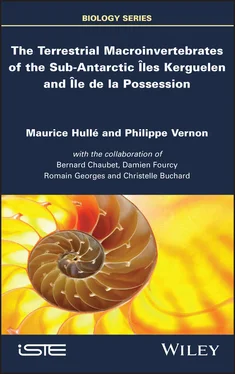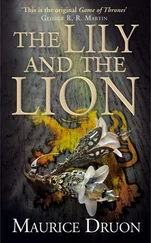We would like to thank Marc Lebouvier who made a major contribution to data acquisition and management, and Christelle Buchard and Romain Georges, who have done a lot of work on species identification, collection management and the identification training we put in place each year for young wintering scientists. We are also very pleased to have been able to illustrate most of the invertebrate species present on the Îles Kerguelen and the Île de la Possession thanks to our fellow photographer, Bernard Chaubet. Damien Fourcy drew all the maps of the Kerguelen and Crozet islands specifically for this book.
We would also like to thank the specialists who brought their expertise on the chapters devoted to the different taxonomic groups: Yves Frenot (earthworms), Maryvonne Charrier (mollusks), Julien Pétillon and Cyril Courtial (spiders), Steven Chown (weevils), Vladimir Gusarov (rove beetles), Adam Broadley (sciarids), Torbjorn Ekrem and Aina Maerk Aspaas (chironomids), Evelyne Turpeau and Christelle Buchard (aphids) and Richard Harrington (lepidopterans).
We are grateful to the “Zone Atelier Antarctique et Terres Australes” ( https://zaantarctique.org/) and to Françoise le Moal for editing the meteorological data from the Kerguelen and Crozet weather stations provided by Météo France. We would also like to thank Clément Quetel and Floran Hoarau of the French Southern Lands National Nature Reserve for the information on the reserve and the maps of the access areas, as well as Yann Laurent and Franck Duval for their drawings of insect morphology.
David Hatcher and Richard Harrington provided invaluable help in proofreading and correcting our French-English.
The entire ISTE team were also a great help in the conception of the book.
Thanks to our supervisory institutes, the University of Rennes 1, the National Centre for Scientific Research (CNRS) and the National Research Institute for Agriculture, Food and Environment (INRAE) for hosting our research activities and signing our mission orders!
Finally, we express our warmest gratitude to Steven Chown and Yvon Le Maho, who agreed to write the forewords of this book and with whom we are happy to share our passion for the sub-Antarctic islands.
The Îles Kerguelen and the Îles Crozet belong to the “Terres Australes et Antarctiques Françaises” (TAAF). They are located in the South Indian Ocean Province. They were discovered in 1772 respectively by Yves Joseph de Kerguelen de Trémarec and Marc-Joseph Marion Dufresne whose first mate, Julien Crozet, had landed on Île de la Possession (Delépine 1995).
After their discovery, these islands remained untouched by any human presence until the whalers and the sealers visited them during the 19th Century and the beginning of the 20th Century. In 1924, they were officially attached to France, who only installed permanent bases there in 1950 on the Îles Kerguelen (Port-aux-Français) and in 1963 on Île de la Possession (Base Alfred Faure).
The history of fauna and flora is affected by the history of human visits. Fauna and flora were originally composed of a small number of native sub-Antarctic species. The first introductions of alien species occurred as early as the 19th Century (rabbits and dandelion in 1874). The number of introduced species increased significantly from the mid-20th Century, and now makes up approximately half of the species present. Some of the introduced species have become invasive. Given the small number of native species and the quantitative importance of introductions, terrestrial ecosystems have been severely disrupted by these invasions, especially as global warming has also caused significant changes in vegetation cover.
Assessing the impact of introduced species on native ecosystems and deciphering the interactions between native and alien species are some of the issues currently being investigated by scientific teams.
Until now, there has been no work presenting all the invertebrate fauna of these islands. Here, we are only considering macroinvertebrates (earthworms, mollusks, spiders and insects) from the Îles Kerguelen and Île de la Possession for which we have an almost complete knowledge. Other groups such as springtails, mites and tardigrades are still undergoing a taxonomic revision.
In the first part, we present the general characteristics of the Îles Kerguelen and Île de la Possession: their geography, their climate and their main landscapes, which constitute the environment and the habitats of terrestrial invertebrates. We also dedicate a paragraph to the first scientific discoveries that marked the knowledge of the natural history of these islands, then briefly mention the current scientific themes concerning invertebrates, as well as the measures of protection that have been put in place since the creation of a natural reserve in 2006.
In the second part, we present all species of macroinvertebrates. For each one, we evoke its status: endemic for the species found only on one of the two archipelagos, native for those present on other islands of the South Indian Ocean Province or other sub-Antarctic provinces, introduced for naturalized alien species and finally transient for species observed regularly but who are not reproducing on the islands. We also give information on known distribution, identification and elements of ecology. For the Archipel Crozet, we only present the fauna of Île de la Possession because the other islands have not been sufficiently explored to have such a thorough knowledge of the species.
1
General Presentation
1.1. Physical environment
1.1.1. Location and size
The sub-Antarctic Îles Kerguelen and Îles Crozet belong to the South Indian Ocean Province, as do the Heard and McDonald Islands, and the Prince Edward Islands (Marion Island and Prince Edward Island) (Figure 1.1). Only Heard Island and McDonald Island are located in the very cold Antarctic waters. The others are located above the Polar Front, separating the very cold Antarctic waters from the sub-Antarctic cold waters.
The Îles Kerguelen are located at 49°21’S, 70°13’E (Port-aux-Français) and Île de la Possession at 46°24’S, 51°46’E (Base Alfred-Faure). They are respectively 3,250 km and 2,800 km from Île de la Réunion, 3,800 km and 2,400 km from South Africa and 1,900 km and 2,100 km from the Antarctic Continent. The Îles Kerguelen and Heard Island are located on the same continental shelf and are only 423 km apart. The Îles Crozet and the Prince Edward Islands are a second, more western subgroup.
The Îles Kerguelen are 130 km long and 120 km wide. Their total area is 7,215 km² including 6,675 km² for the main island which is called Grande Terre (Figure 1.2). The Îles Crozet are composed of an eastern group of islands (Île de l’Est and Île de la Possession) and a western group about 110 km away (Îlots des Apôtres, Île aux Cochons and Île des Pingouins) (Figure 1.3). Île de la Possession, the only inhabited island, is much smaller than Grande Terre, at only 150 km².
The morphology of the Îles Kerguelen is mainly related to their magmatic origin and glacial erosion. Their geological history is long. The most ancient parts emerged about 35–40 million years ago and the last magmatic events date back to about 30,000 years ago. Mount Ross rises to the South at 1,830 m a.s.l. Part of the western and central regions is covered by an ice cap, the Cook cap, which rises to 1,000 m a.s.l. and covers about 550 km². The North (Péninsule Loranchet) and the South-West (Péninsule Rallier du Baty) are mountainous and rise to 1,260 m a.s.l. To the east, Péninsule Courbet constitutes a vast area of glacial erosion which is at a low altitude and is dotted with numerous lakes (Giret et al . 2003a) (Figure 1.4).
Читать дальше












